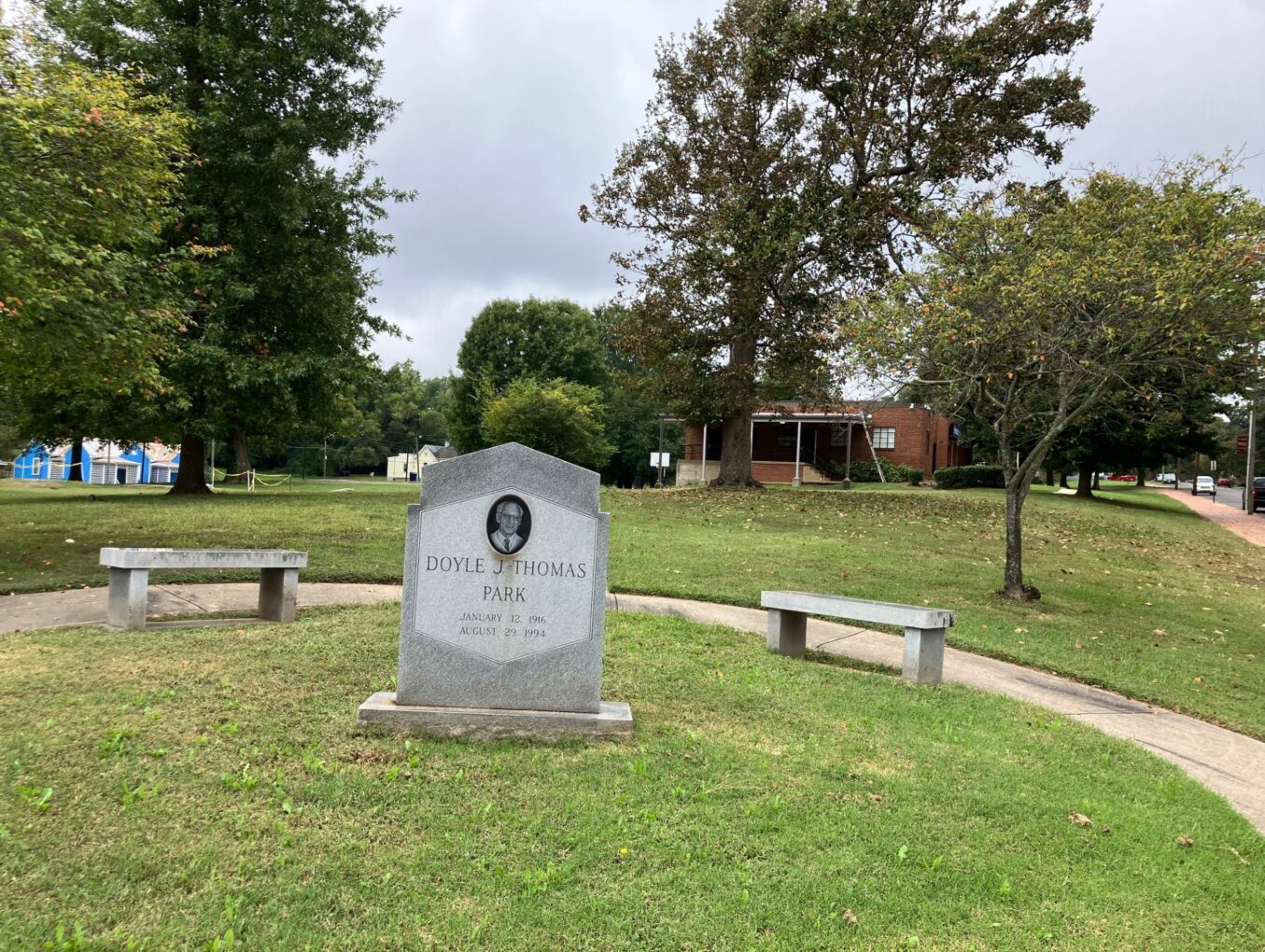The green space in the 800 block of Green Street was originally part of the large estate of Dr. Nathaniel Terry Green. Dr. Green was a native of Halifax County, born on the 10th of March 1800, the s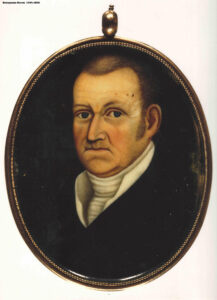 eventh of eight children born to Captain Berryman Green and Nancy Terry Green. He married Anne Colquhoun in 1818, and the couple had ten children. Dr. Green came to Danville at an early age and studied medicine under the elder Dr. Paxton and taught school under Levi Holbrook at the Danville Male Academy. He later went to Philadelphia to obtain a formal medical training and returned to Danville to practice medicine with Dr. Patton.
eventh of eight children born to Captain Berryman Green and Nancy Terry Green. He married Anne Colquhoun in 1818, and the couple had ten children. Dr. Green came to Danville at an early age and studied medicine under the elder Dr. Paxton and taught school under Levi Holbrook at the Danville Male Academy. He later went to Philadelphia to obtain a formal medical training and returned to Danville to practice medicine with Dr. Patton.
The seat of the Green estate, Dr. Green’s family home, was located on the block of Jefferson Avenue between Colquhoun and Lee Streets, later addressed as 653 Jefferson Avenue (Street). When he prepared his will in March of 1860, he left his house and 20 acres of land to his living, unmarried daughters, Maria, Julia, and Sarah. Dr. Green died just months before the opening of the Civil War and could not have imagined what the hardship that secession and war would bring to his family or his estate.
According to Karen Lynn Byrne in her master’s thesis on Danville’s Civil War Prisons, which she wrote in 1993 for Virginia Polytechnic Institute, by 1863 this “unique” and “exceedingly attractive city” “presented an appearance of general desolation. ”The price of food had skyrocketed. Butter, which had sold for 20¢ before the war rose to $3.00 per pound by 1863. Potatoes went from $1.37 a bushel to $6.00. And those were the prices for items that could be got. Coffee disappeared, and flour became so scarce it was auctioned off by the ounce.”
As we discussed in a previous article on Danville’s Civil War Prisons, Danville’s native population during this time dwindled, refugees—mostly women and children—from the embattled regions of Virginia, from the coast and the environs to the North, flooded into the town, swelling the population to 6,000. The lack of housing reached a crisis level when hotels and boarding houses ceased to have vacancies. Local families opened their homes to strangers so that, “every house was filled to the limit of its capacity.” These new inhabitants did not add to the labor force and instead placed an additional burden upon the city’s waning resources.
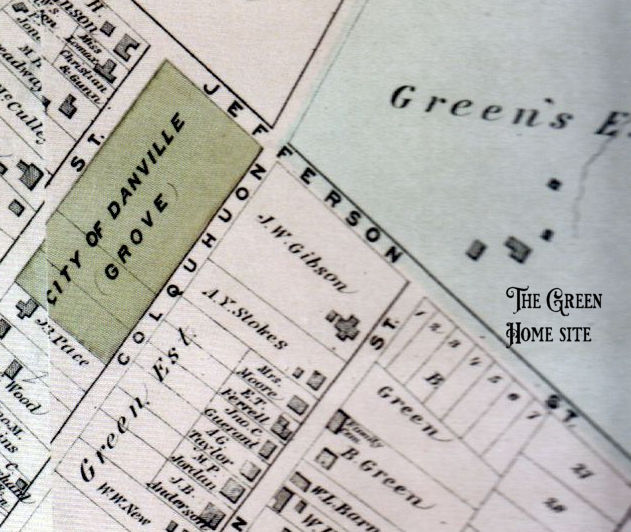 That strain would only be made greater when, in May of 1862, the Confederacy established a military hospital in Danville on the corner of Jefferson Avenue and Loyal Street. Whether that hospital occupied a building that was standing already (that of the Danville Female Academy, perhaps) or on an empty lot nearby, it is difficult to say. Regardless, the resources such a facility required for the treatment of its sick and injured (both Confederate and Union alike) were difficult, if not impossible, to come by, and these wounded soldiers arrived in Danville more to suffer and die than to recuperate. These deaths required burial, and with the arrival of Union prisoners in 1863 and, with them, the disease and illness they brought, the city was soon desperate for green space on which to bury these men. What other purpose the city had for wishing to purchase 35 acres of the Green estate is open to speculation. The Green home site became Green Hill, Veteran’s Memorial, and Freedman’s Cemeteries, but a portion of that property was also set aside as permanent green space.
That strain would only be made greater when, in May of 1862, the Confederacy established a military hospital in Danville on the corner of Jefferson Avenue and Loyal Street. Whether that hospital occupied a building that was standing already (that of the Danville Female Academy, perhaps) or on an empty lot nearby, it is difficult to say. Regardless, the resources such a facility required for the treatment of its sick and injured (both Confederate and Union alike) were difficult, if not impossible, to come by, and these wounded soldiers arrived in Danville more to suffer and die than to recuperate. These deaths required burial, and with the arrival of Union prisoners in 1863 and, with them, the disease and illness they brought, the city was soon desperate for green space on which to bury these men. What other purpose the city had for wishing to purchase 35 acres of the Green estate is open to speculation. The Green home site became Green Hill, Veteran’s Memorial, and Freedman’s Cemeteries, but a portion of that property was also set aside as permanent green space.
On the Beers map of 1877, that green space is identified as the “Grove” but soon became known as Green Street Park.

Since its establishment, Green Street Park has vacillated between a garden of recreation and community harmony and one of violence and neglect. We know little about it between the years of the city’s acquisition and the turn of the 20th century. The park’s earliest recorded episode of violence, however, occurred in July of 1907 when an altercation occurred between two gentlemen. George D. Gravely, a driver for Star Laundry Company and Samuel G. Smith who worked as a butcher for Walters & Moorman, were neighbors on Paxton Street. The butcher’s shop was located in the Five Forks area, and, as Mr. Gravely passed it on the way to the park that summer morning, he saw the oldest son of Mr. Smith sitting on the shop steps waiting for the store to open. As he passed by, the young man allegedly threw a rock at him. Gravely asked where the young man’s father was and was told that the senior Mr. Smith was sitting in the park, as he often did, before the start of his work day, and so Mr. Gravely headed in that direction.
Mr. Gravely found Mr. Smith near the corner of Colquhoun and Jefferson streets when Mr. Gravely approached Mr. Smith and told him that something must be done about his children’s propensity to throw rocks at him. Smith said he didn’t see what he could do about it, and Mr. Gravely accused Smith of being the instigator, even going so far as to suggest Smith was supplying rocks to his children for the purpose of throwing them at Mr. Gravely. Smith called Gravely a liar, and Gravely threw a fist, fracturing Smith’s jaw. Another fist struck Smith in the eye and knocked him to the ground. Gravely, for a moment, had him pinned, and Smith told him to get off of him. Gravely raised himself, and, as he did so, pulled a gun from his pocket and shot Smith twice, aiming at his head. One struck, but not fatally, entering through the top of his head and planting itself in his throat. Smith lived, but by the time of the trial in September, he had lost considerable weight and appeared quite frail. The September trial resulted in a hung jury, and the charges were retried in December. Gravely was found guilty of felonious assault and sentenced to thirteen months in the state penitentiary. By October he was released, having served a reduced sentence for good behavior and, upon returning home, was charged with a civil suit by Mr. Smith. Smith won and was awarded $650 in damages. Smith survived his wounds and died in 1940 at the age of 82.
In 1911, the park experienced its first period of endangerment (one of many that would occur over the ensuing years) when the city’s school board proposed building a new school to replace the Loyal Street School that was to be demolished. The new school, along with a playground, would be built on the park grounds. The motion met with considerable opposition. At the next city council meeting, the neighborhood (those living on the streets surrounding the park) turned out in numbers to protest the idea. The deed for the land included an agreement that the green space between Colquhoun Street and Green Street and bounded by Jefferson (then) Avenue must be preserved as green space, after all. The idea was ultimately abandoned, but by 1915, the city was threatening once again to use the park as a school site, this time for a new high school.
An editorial in the Danville Register and Bee dated 20 June 1915 read as follows:
Our city, perhaps, has never done very much for Green Street Park, not even conferring a fitting name upon our only real “square”. But then Nature has done so much that perhaps the greatest thing the city could do for it was to let it alone. In its unadorned and unspoiled beauty, despite a few ancient assaults with its splendid surviving grove of Druidical oaks, it is, by Nature, the finest public reservation in the city of Danville; and any visiting metropolitan park commissioner would undoubtedly so pronounce it. Let us hope and pray that some angel with a flaming sword will guard this garden of our artistic innocency from the insidious approach and specious pledging of all the utilitarians once before cast out!
In the years that followed, it seems the city government began to see the benefit of preserving the green space as a public park. Around 1920, lights were installed in the park with the idea that the adult residents who lived nearby might enjoy the evening air after their children had been put to bed. The lights, however, invited nighttime activities of an undesirable kind, the neighborhood was soon to learn, and the city, in response, added an evening patrolman and proposed the removal of the park’s playground equipment. At the following City Council meeting, two gentlemen from Kiwanis stood to attest to the effectiveness of the patrolmen and to assure the Council that the measure of removing playground equipment was unnecessary. The City abandoned the notion.
When brick walking paths were installed, another uproar occurred. Nowhere else in the whole of the United States, editorials of the time contested, had brick walkways been used in parks. Many thought the idea ridiculous and something that could only take away from the pristine and untouched beauty of the park in all its wildness. By July of that year, playground equipment was being installed, a neighborhood recreation organization was formed, and, in 1922, a wading pool was added.
In the 1930s, Memorial Day celebrations included the encampment of National Guard who spent the night before the holiday billeted in the park. In the morning, they marched to the cemetery and there conducted services. The park was also a place where disgruntled mill workers met to plan their strikes and to set up demonstrations.
Throughout the 1940s, the park was a haven of bustling activity where people met to enjoy team sports such as baseball, volleyball, tennis, and badminton or “areal tennis”. The baseball teams, called “twilight teams”, held evening games and competed with other neighborhoods. There was even a community singing program and supervised play times for children whose parents worked or desired a break or who wished to gather and meet with other mothers. After the games, the community would sometimes show movies on a large screen, proving the park’s value as a community gathering place.
In 1955, the school board was once again requesting the acquisition of Green Street Park for the construction of a primary school building. The city council met in February of that year and flatly denied the proposal, but when the city met again in April, the resolution passed in a 5-4 vote. A week later, a second vote was held, and it, too, passed. The request was made as a result of the closure of Robert E. Lee School but passed only on the condition that no other solution could be found. The neighborhood was once more up in arms and appeared at the third meeting to protest loudly the proposal. Eventually it was remembered that terms of the purchase of the land stipulated that it could only be used for recreation. The city sought to change the terms, but eventually abandoned the idea. After a fierce battle, the idea was at last voted down.
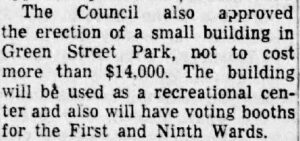 Two years later, however, the first major development for the park in the way of building construction was proposed. There seems to have been little objection to the erection of what was intended from the start to be a recreation center. Constructed in 1957, the building was, rather ironically, used as a kindergarten for the first ten years of its existence.
Two years later, however, the first major development for the park in the way of building construction was proposed. There seems to have been little objection to the erection of what was intended from the start to be a recreation center. Constructed in 1957, the building was, rather ironically, used as a kindergarten for the first ten years of its existence.
For the decade that followed, there is very little written about the park in the papers apart from the very popular “twilight teams” who played baseball and sometimes other sports in the park. The papers of that era are filled with the names of local teams, usually affiliated with one of the many parks, including Green Street Park whose baseball team proudly won the city tournament in 1964.

There is some verbal history that suggests that there may have been some racial demonstrations held at the park in the 1960s, but the papers give no evidence of that. Organized demonstrations and rallies sponsored by the Danville Christian Progressive Association whose headquarters were High Street Baptist Church, were typically held at various locations on Main Street and at Peters Park, a once nationally famous ball field in Almagro off of Industrial Avenue. The park and its stadium were closed in anticipation of Dr. Martin Luther King’s visit to Danville in July of 1963. Clearly, however, racial tensions were on display in the park, which tensions resulted in 1964 with the removal of the park’s playground equipment, probably more as a response to desegregation than because there were actual protests here, though its possible those protests followed the closing of the playground. Research and history have yet to fill in the gaps in that story.
The playground was reopened three years later in November of 1967 and was instantly flooded by young people. In August of the following year, Parks and Recreation announced that Green Street Park had the highest attendance for any of the summer programs, counting more than 11,500 individual children registered.
With the dawning of a new decade, and with the removal of downtown businesses into the suburban areas, the Green Street area began to descend into some dark times. When the city proposed zoning for a historic district in 1971, city engineer Victor White described Green Street as suffering from “lack of maintenance, overcrowding on individual lots of small size, lack of maintenance of lawns and plantings, and sidewalk deficiencies.” Drugs and violence began to be a real problem, and the city’s police were inundated with complaints. The following are a few examples reported in the papers.
7 July 1970: Raymond Heath was standing on the corner of Green and Jefferson streets near his home at 808 Green Street when two men approached him. They searched him, took ten dollars from his pocket, and took off running into the park. Ten days later, witnesses saw a group of “subjects” carrying a parking meter into the park, where they broke into it, robbed it of its stash of coins, and then abandoned it.
4 August 1971: Frederick Williamson of 845 Colquhoun Street was struck in the head with a bottle while walking in the park. Later that month, the same article mentions a “fight” which took place in the park, but offered no further details of the event.
22 September 1976: Phillip Barksdale, 19, was shot in the leg while visiting the park. Herman Lee Strader, of 679 Colquhoun Street was charged with assault and battery after attacking Wayne Holmes in the park.
In June of 1979, a horseshoe competition was held in the park. When one of the participants got angry over the outcome of a game, he pulled a gun from his side and shot six rounds into the crowd of people who had gathered to watch. He then fled the scene, leaving officials and police to worry for the reputation and future of the park.
In the mid 80s, the city allocated money for the renovation and renewal of several of its parks. By then, many of the Old West End’s large homes had been converted into apartment houses. Overcrowding was an issue, and there was a deep racial divide. The proposed renovations, many of the neighborhood’s white residents felt, would benefit their black neighbors disproportionately–at least the installation of more basketball courts would encourage more young black men to use the park, theoretically pushing others out. In response to the opposition, one Pine Street resident spoke out. “The only weapon we have is fairness,” she said, acknowledging that black people in the community had little leverage with an all white city council.
There was, however, reason to be concerned with those who were, at the time, using the park for nefarious purposes. Drugs and violence were on the rise, and those participating in criminal activity had no qualms about carrying their business out in public. The temporary closing of the park in preparation of its impending improvements did more, as it turned out, to encourage these activities than to discourage them. With crime at an all time high, a Neighborhood Crime Watch program was initiated with a Crime Stoppers number and the enticement of monetary reward for information that lead to the capture and conviction of drug traffickers. This only led to an increase of complaints as crime continued unabated. At last the city assembled a task force to inspect the area and propose changes. But rather than evaluate the park, they instead put the blame on the landlords and homeowners on the streets that surrounded the green space. Landlords were asked to make improvements, but money was tight for many of these people who saw no point in fixing up their properties in a neighborhood that seemed to be perpetually on the decline. Tenants were encouraged to demand better conditions, but many of these were recipients of government help, including Section 8 housing. If they were evicted, where would they go? The task force found, apart from general disrepair, that many of the apartments were actually unsafe, with doors that did not lock and windows that were broken or otherwise inoperable. In many cases, the requisite emergency exits did not exist or were in poor repair. The task force also identified the source of crime, or at least a contributor to it, to be the prevalence of drugs sold by residents and tenants or purchased by them. There were also several nearby “nip joints”, these were businesses or even residences where bootleg whisky was sold in small quantities. Contributing to these problems were the laundromat at Five Forks, where as many as thirty people at a time would gather to “hang out”, drink, smoke, and buy and use drugs. The convenience store across the street was another popular hangout for drunks who could easily access alcohol there in small quantities and, consequently, did not wander too far in case they found themselves in want of more. Indeed, police found little blame to be placed upon the park itself, despite the fact that a budget had been allotted for a regular patrol in the park and yet no patrolman had been assigned. Not for years!
After a series of public meetings to which few residents came, the task force proposed a plan that included cracking down on landlords of section 8 housing and enforcing building codes, investing in improved lighting, and, at long last, assigning regular patrols, but not to the park itself, rather they felt it necessary to target residences they felt might be sources of illegal drugs, alcohol, prostitution, and gambling. They also suggested more park programming for children. But who wanted to send their children to that park?
A year later, in August of 1988, after visible improvements had been made to a dozen or so houses, the city congratulated itself on the progress it was seeing.
And then in May, a Cleveland Street man was stabbed while walking through the park.
By November of 1989, the program was considered “a total flop”.
In spring of 1992, City Council put the park on “probation”, closing it temporarily while they figured out what to do. Apart from increasing police presence, the idea was floated that they might simply just raze the basketball court and recreation building. The playground had not been reopened since its closure in the mid 1980s. Doyle J. Thomas, a city councilman, local minister, and president of the local chapter of the National Association for the Advancement of Colored People, opposed that idea. He begged his colleagues to give the park, and the neighborhood, one last chance and a proper effort at redemption.
In response, the recreation center was turned into a community policing office.
A year later, in 1993 with drug arrests down and fewer complaints regarding felonious activities in the area, the park was given a “clean bill of health.”
In August of 1995, the park reopened with new playground equipment and a new sense of community pride. Much credit was given to Doyle Thomas who, almost alone, won the opportunity for the park to redeem itself, and for the neighbors, including the newly formed Old West End Historic Neighborhood Association, who encouraged those who used and loved the park to stand up and take responsibility for their neighborhood and its endangered amenities and resources. The opening ceremony for the new park installation remembered the man who had come to the park’s ( and the neighborhood’s) defense.
Doyle Thomas, councilman, minister, and Civil Rights leader, died in 1994. Born in Pittsylvania County, Dr. Thomas came to Danville in 1946 when he took up the mantel of leadership of Loyal Baptist Church. Reverend Thomas was a close friend of Dr. Martin Luther King, Jr. “Those who worked with him on the city council described him as a compassionate man who brought his humanitarian concerns to government,” said a memorial printed in the Danville Register and Bee in August of 1994. Dr. Thomas served eight years on the city council from 1986 until his death in 1994. “There was an element of mischievousness in Doyle,” then Mayor F. Seward Anderson was quoted to say about him. “A lot of people are uncomfortable around a minister, but Doyle was so disarming that everybody felt comfortable around him. Of his greatest accomplishments, according to councilwoman Joyce Glaise, was his successful effort to save Green Street Park.
In July of 1988, it was proposed that Green Street Park’s name be changed to Doyle J. Thomas Park. The idea was not without its controversy. Though the street and park had named in honor of another historic Danvillian, to many it only seemed fitting that the park, now wrested from crime and restored to the community that surrounds it, should honor and be honored by the one man who allowed it to be so. The Park would always be the crowning glory of Green Street, after all. That name would never change.
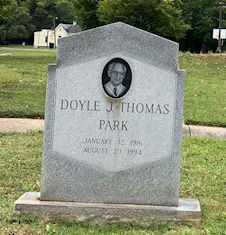 The controversy, as adopted by those in the city council who opposed the name change, came down, as it always does, to “practical” semantics: money. The city, while it reluctantly agreed to a nominal change, would not back the necessary funding of an official commemorative structure. It wasn’t until June 8, 2000 that the dedication took place, attended by 150 people, including Reverend Thomas’s widow, Eva, his son, Doyle Thomas Jr, and his granddaughter. The granite marker, which included the new name of the park and a picture of Rev. Thomas, as well as signs at each corner of the park, were paid for with private funding.
The controversy, as adopted by those in the city council who opposed the name change, came down, as it always does, to “practical” semantics: money. The city, while it reluctantly agreed to a nominal change, would not back the necessary funding of an official commemorative structure. It wasn’t until June 8, 2000 that the dedication took place, attended by 150 people, including Reverend Thomas’s widow, Eva, his son, Doyle Thomas Jr, and his granddaughter. The granite marker, which included the new name of the park and a picture of Rev. Thomas, as well as signs at each corner of the park, were paid for with private funding.
Today, with the recently installed spray pad and improved parking and equipment, the park is equal parts a center for recreation and play and green space. Residents of the Old West End, looking forward to a future that includes the potentiality of annexing the neighboring streets of Colquhoun and Paxton streets, and situated as it is on the edge of Five Forks neighborhood, hope the park will and continues to serve as a bridge between communities, where all children are welcome to play, and neighbors can meet and form new friendships and connections.
Sources:
Census and Vital records found at Familysearch.org
Images and vital information, including biographical sketches found at FindaGrave.com
Death notices and other information found in the Danville Register, Danville Bee and other newspaper archives at Newspapers.com and GenealogyBank.com
Census, Directory, Newspaper, and other information compiled by Paul Liepe
